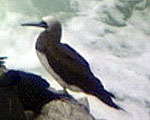Brown Booby
Pt. Reyes Lighthouse
Marin County, California
7 June 1998
 I checked the birdbox this morning to hear Joan Humphrey report a Brown Booby on the rocks
off the lighthouse observation deck. I hadn't had much sleep and figured it probably wouldn't be around by the
time I got there so I decided to get some work done instead. About an hour later I called the birdbox again (compulsion?)
to hear Rich Stallcup report a Worm-eating Warbler, several Rose-breasted Grosbeaks as well as the booby. That
prompted me to move and I arrived at the lighthouse by 3pm only to learn that the booby had flown about a half
hour earlier. A female Rose-breasted Grosbeak in the trees was slim consolation. My timing couldn't have been worse.
I checked the birdbox this morning to hear Joan Humphrey report a Brown Booby on the rocks
off the lighthouse observation deck. I hadn't had much sleep and figured it probably wouldn't be around by the
time I got there so I decided to get some work done instead. About an hour later I called the birdbox again (compulsion?)
to hear Rich Stallcup report a Worm-eating Warbler, several Rose-breasted Grosbeaks as well as the booby. That
prompted me to move and I arrived at the lighthouse by 3pm only to learn that the booby had flown about a half
hour earlier. A female Rose-breasted Grosbeak in the trees was slim consolation. My timing couldn't have been worse.
Learning of a female Hooded Warbler at the Fish Docks I elected to leave the booby vigil at the overlook and try for the warbler. I lucked out finding a White-throated Sparrow and the female Hooded Warbler in the trees on the south side of the quad. As I was leaving, I met Roger Harshaw who had just seen the booby back at the lighthouse. I called David Dixon of PRBO who was still looking for the skulking Hooded Warbler and we made it to the observation platform in record time to see the bird still sitting exactly where Roger had said it was.
It was on the ledge of the rightmost rock off the observation platform. We were able to study it through scopes for over an hour in fair light conditions. I used a KOWA TSN4 and most observations were at high power. The following is based on notes taken while watching the bird:
An obvious booby with a long, cone-shaped bill and long pointed tail. It spent most of its time preening allowing us to view almost all of the bird's feathering. It was decidedly smaller than the adjacent Brandt's Cormorants and larger than nearby Heermann's Gull. I judged body size to be comparable to Western Gull, but the head and bill were larger and the legs much shorter. It was definitely larger than the female Black Scoter swimming behind it in the water. (Just had to get that in...how often do you see those two species in the same scope view?)
The upperparts were brown with an obvious whitish forehead which blended with the pale-brown crown, nape and face. The overall crown pattern recalled Brown Noddy and was very striking. Thebill and legs were gray, the bill sometimes showing a steel-gray cast, especially at the base. When the bird opened its bill, the gape appeared bluish. A black mask surrounded the lower portion of the bill out to the eye, and contrasted with the white forehead and pale brown cheeks.
The throat and foreneck were dark, chocolate brown, but a white crescent shaped mark showed just under the bill at the chin. The foreneck extended part way down onto the breast where it was sharply and squarely demarcated from the immaculate white underparts.
The rest of the upperparts were a uniform chocolate brown, contrasting slightly with coffee brown primaries, secondaries and rectrices. These darker remiges could be seen as the bird spread its wings to preen several times. The scapular feathers were somewhat loose, blowing in the wind and showing a dark shadow line between the scapulars and wing coverts.
Once the bird raised its wings to show the underwing pattern which was clean white connecting to the sides and flanks, but bordered by blackish marginal coverts and patagium along the leading edgeand a broader dark trailing edge caused by the dark remiges. The dark border on the trailing edge was somewhat fuzzy along the border between the remiges and the underwing coverts.
The bird spent the whole time standing just below the top ledge, so it was difficult to get a detailed look at the feet, but what I could see of them seemed large and paddle-shaped.
This is the third Brown Booby I have seen in California, the first being an immature at the Salton Sea in August 1972, and the second being an immature at Southeast Farallon Island in August 1992. This is the first adult I have seen in California, and the strikingly pale forehead, crown and chin is characteristic of adult males of the race "S. l. brewsteri" of the Eastern Pacific. However, the amount of white on the nape was not as extreme as described for birds off w. Mexico where almost the whole head is white (Palmer, Handbook of NA Birds, vol. 1, 1962) suggesting that this bird may have come from somewhere else in the Eastern Pacific.
Account written 7 June 1998.
--
Joseph Morlan
380 Talbot Avenue #206
Pacifica, CA 94044